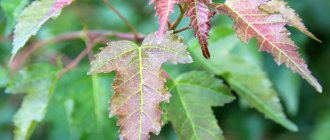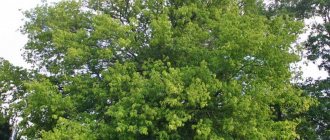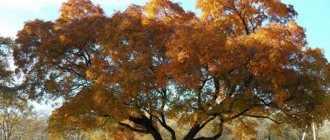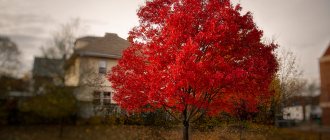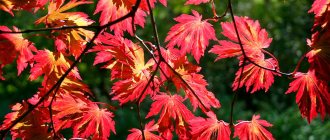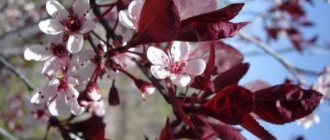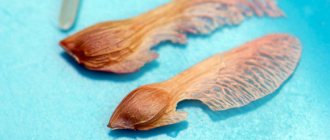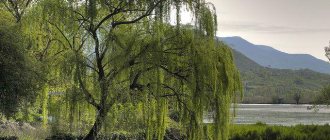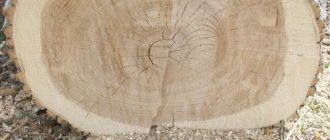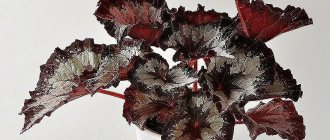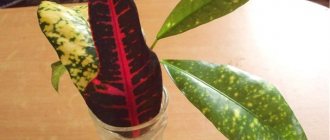The maple that everyone knows.
The most common type of maple growing in our country is the Norway maple (Acer platanoides) , which, unlike many others, is found not in mountain forests, but in lowland forests. Its appearance and characteristic leaves are well known to all people, even those far from dendrology. This is a tree up to 30 m tall with an ovoid, tent-shaped dense crown.
The varietal diversity of Norway maple is so great that, using only it, you can create interesting wood compositions. There are color forms, varieties with a modified growth form and leaf blade. Maples look especially impressive with unusual leaf colors, such as purple, as in the varieties 'Royal Red', 'Crimson King', 'Deborah', 'Schwedleri', or with a white stripe along the edge of the leaf blade, as in 'Drummondii'. Decorative forms 'Columnare' and 'Globosum' attract attention with their crowns - columnar and spherical, which makes them a bright accent in compositions. They are also good in co-letter and row plantings.
Types of maples: tall and majestic
Among the maples there are very large representatives. One of them is the majestic maple, or velvety maple (Acer velutinum) , which grows in eastern Transcaucasia and the mountains of Northern Iran. With a height of 50 m, it looks like a real giant, moreover, the diameter of its trunk reaches 1.2 m. This maple looks especially impressive during fruiting, when it is decorated with large hanging fruiting panicles carrying up to 60 lionfish. A truly majestic sight.
The false sycamore maple (Acer pseudoplatanus) is slightly smaller in size and is a typical representative of the mountain forests of the southwestern part of Ukraine and the Caucasus. Tree up to 40 m tall and up to 2 m in diameter with dark gray bark peeling off in plates to reveal light young bark. It is especially beautiful when standing freely; it forms a dense tent-shaped crown. In ornamental gardening, various forms of false sycamore maple are most often used. The variety 'Purpurea' has two-colored leaves, dark green above and purple below. Young leaves of the 'Leopoldii' variety are covered with yellowish-pink spots, while mature leaves are variegated, with uneven, light green or cream spots.
No less monumental is the North American silver maple (Acer saccharinum) , reaching a height of 40 m with a trunk up to 1.5 m in diameter.
A characteristic feature of this species are deeply dissected five-lobed leaves on long petioles. They are light green above and silvery-white below, hence the specific name. In autumn, this maple stands out with light yellow foliage. It looks great along the banks of reservoirs, in alleys and group plantings, but it should be remembered that its branches often break off from adhered snow and strong gusts of wind. The decorative variety 'Wieri' is notable for its elegant carved foliage and picturesque crown with long, hanging shoots.
Rules of care
White maple needs a lot of moisture . In cool weather in spring and autumn, it should be additionally moistened once a month. In hot and dry summers - at least once a week. Young seedlings require 15–20 liters of water, mature trees - about 10 liters. After watering, the soil must be loosened to a depth of 7–10 cm, and all weeds must be removed.
If maples were planted in fertile soil, you can start fertilizing them next year. Any organic matter is useful: rotted manure, peat, compost or humus. Fertilizing is spread around the trunk 1-2 times a season. In spring it is recommended to apply nitrogen fertilizers.
For the winter, young sycamore trees must be insulated . Before frost begins, the root system is covered with a thick layer of leaves or spruce branches. The crowns are wrapped in burlap. From 5–6 years of age, trees adapt better to winter cold and no longer need additional protection. They need to be covered only during prolonged frosts below –20 °C.
Sanitary pruning is necessary for maples every year . It is carried out in March, removing all frosty shoots. When forming a crown, incorrectly growing and twisted branches need to be shortened or cut out entirely. You should also get rid of the root shoots that regularly appear on mature trees. If necessary, you can give the crowns the desired shape by pruning young shoots. However, sycamores rarely need this, since they are decorative and neat by nature.
Far Eastern maples
It is believed that maples are the face of the Far East. There they live in the mountains and along river valleys. Their appearance differs from European and North American species, which has recently been appreciated by landscape designers who are actively using them. In addition, growing most Far Eastern maples in central Russia does not present any particular problems, with the exception of some species. In the Central Russian landscape, they look like real exotics, which with their appearance can decorate any composition.
The river maple (Acer ginnala), widely known in cultivation, is distinguished by its high frost resistance and unpretentiousness. Growing up to 6 m in height, it is quite suitable for creating hedges and single plantings. In autumn, its three-lobed leaves turn purplish-red, imbuing the landscape with vibrant colors.
, green maple (Acer tegmentosum) grows , the trunk of which is decorated with smooth green bark with longitudinal white stripes. With such an unusual bark, maple always stands out from other plants.
When listing the Far Eastern species, one cannot fail to mention the small-leaved maple (Acer mono), . This is a tree up to 15 m high with a low crown. The leaves are similar to the foliage of Norway maple, but 2 - 3 times smaller. In autumn they turn bright yellow and red. Small leaf maple plantings effectively reduce city noise.
If we talk about the beauty of the leaves, then, of course, first of all it is worth mentioning the palm maple, or fan maple (Acer palmatum) , without which not a single garden in Japan can do. Its openwork dissected leaves acquire bright, picturesque colors in autumn. Unfortunately, this species is quite thermophilic and in central Russia it freezes to the level of snow cover. Therefore, to create a stylized Japanese garden in our climate, the best replacement would be the no less spectacular Manchurian maple (Acer mandschuricum) and false maple (Acer pseudosieboldianum) .
Maple fruits
In Soviet times, maples of various types were actively planted in parks. But today, such close attention is not paid to the improvement of urban areas, so no one is engaged in mass planting of trees. However, there are only more maples. What is the reason for this fact?
Everything is very simple. The fact is that maples reproduce well by self-fall. Their fruits are able to germinate and literally in a couple of years turn from a timid sprout into a full-fledged young tree.
Such survival is ensured by the very shape of the fruit. They resemble a small propeller that stays on the branch almost until frost. Then gusts of wind carry these “helicopters” throughout the surrounding area, where they wait for the onset of spring.
Usually no more than ten percent of the seeds germinate, but this amount is enough to maintain the maple population.
North American maple species
A large number of maples grow on the North American continent. Many of them have long settled in Russia, having acquired a second homeland, and the ash maple (Acer negundo) has become so naturalized in our open spaces that it sometimes behaves like a weed. Now it is difficult to imagine that this plant was previously grown in greenhouses as a valuable exotic. Currently, ash-leaved maple is widespread in cultivation. First of all, due to its rapid growth, frost resistance and undemanding soil conditions. However, its fragility and low decorative qualities make it necessary to use this species as a temporary breed with others - slowly growing, but more decorative. There are a number of interesting color forms of this maple, which are widely used in landscaping: Aureovariegatum, Variegatum, Flamingo, Odessanum.
Red maple (Acer rubrum) , growing in river valleys and swamps, tolerates excess moisture and stagnant water, and is not picky about soil. It received its specific name for the red female flowers and the orange-red color of the leaves in autumn. Its decorative forms, 'Red Sunset' and 'Scanlon', are characterized by a pyramidal crown shape and dark red leaves in autumn.
The Pennsylvania maple (Acer pensylvanicum) attracts attention with its very beautiful smooth green bark with white longitudinal stripes . Its large three-lobed leaves turn a rich yellow color in autumn. The flowering and fruiting of this maple looks impressive: the flowers and then the fruits are collected in long, hanging clusters.
Maple bonsai
For connoisseurs of real art, it will be interesting to purchase a maple Bonsai. These are plants grown with special pruning and in the future need pruning. Such maples are quite capricious and require special care and special growing conditions. Bonsai maples are small in stature and look very decorative.
Maple bonsai.
Red, Norway, Japanese, rock and field maples are suitable for bonsai. Plants with small foliage are especially valued.
Shrub maples
Among the maples there are also shrubby species that fit well into small gardens.
They also tolerate shearing well, so they make very dense and impressive hedges. These maples include - in addition to the above-mentioned riverine maple and false Siebold maple - also bearded maple, curled maple, Tatarian maple.
Bearded maple (Acer barbinerve) is very beautiful during flowering; in autumn it can boast dark yellow or orange leaves, and in winter its young shoots with purple-red bark stand out against the background of white snow. It shapes and cuts beautifully.
Very decorative throughout the growing season North American
What does a motley giant look like?
Among the different types of plane trees, there are also charming ornamental trees that are planted to improve areas. Residents of the Caucasus call the divine plane tree “plane tree”. Trees grow for hundreds of years, and long-lived champions witnessed the flora of our planet more than two thousand years ago. In the thicket, where many “camouflaged” counterparts coexist, plane trees are tall and slender. And in spaces where you can roam, their peaks grow in breadth and resemble spreading giants. The diameter of the trunk reaches truly heroic dimensions - up to three tens of meters.
At first, it seems that the light spots on the dark green background of the bark are an optical illusion or a play of sunlight. It turns out that the surface of the tree is covered with peeling scales, which are so similar to military camouflage spots. The peeling bark of this species is explained by the fact that the trunk of the plane tree grows very intensively. The plant seems to get rid of old areas of the surface, replacing them with updated ones. Popular fantasy has given the plane tree the nickname “shameless tree”: they say, it sheds its clothes like a girl of easy virtue, not ashamed of anyone.
Where else are maples used?
Many types of maple have valuable wood, which is used in the furniture industry, for the manufacture of sports equipment and musical instruments, in particular bowed instruments.
The sap of maple trees contains quite a lot of sugar, especially in species native to North America, such as the sugar maple (Acer saccharum). In Canada, the sap of this maple is used to obtain maple sugar, and its leaf is the national symbol of the country. A stylized image of a carved sugar maple leaf appears on the jackets of Canadian hockey players and on the Canadian flag.
Wood Maple frame
There are approximately 160 varieties of maple throughout the world, but only 25 can be found in Russia. The most common of them are Norway maple, field maple and white maple.
Maple - fast-growing plants with a height of 10 to 40 meters, belongs to the Sapindaceae family, and is part of the Horse-chestnut subfamily. In a year, the plant can grow one and a half meters. Sometimes there are also shrubs with small branches growing from the base of the trunk. On average, maple trees live up to 200 years. These plants are deciduous. Maple grows very well next to oak and ash.
The bark of the plant has a gray tint, the trunk is covered with small cracks. Maple has heavy and dense wood, white with a yellowish tint. The node contains two identical leaves on opposite sides of the stem. The flower consists of five petals, arranged symmetrically and folded into a tassel. Most maple species have palmate leaves. They can be red, orange, green and yellow, and sometimes you can find a combination of several shades on one leaf.
At the end of April, small yellow-green flowers appear on maple branches. Flowering occurs for about one and a half to two weeks, after which patterned leaves appear on the tree. They are large, rounded-angular in shape, with pointed ends. They are riddled with veins. Branching out, they form a network.
The fruits are called lionfish and consist of two parts. With the help of the wind, they fall and swirl, carrying away the seeds. In this way they multiply and by the end of spring some will grow into trees. The fruit ripens two to six weeks after flowering.
The trees are most common in the northern part of the Earth, from Europe to South Asia, but are also found in the tropics. Maple also grows in mixed forests and loves lighted places. Due to the fact that maple does not tolerate extreme heat and cold, it grows in temperate climates, but it is resistant to drought and can live for a long time without water.
The enemy of plants are lepidopteran larvae that eat leaves. Aphids also settle on them.
Maple is a honey plant. Its leaves can emit a strong odor, which makes bees flock to it. Squirrels also like maple pollen. Syrup is obtained from certain types, and in the spring sugar can be extracted from the juice. The sap is collected by cutting the stem and boiling to a syrup.
Thanks to its thick and spreading crown, maple is used to decorate parks. Wood is also used for carving, creating various patterns and engravings, and because of its durability it is used as parquet. Wood is used to make furniture, musical instruments, or even skis and skateboards. Previously, dishes and bowling pins were made from maple.
2nd, 3rd, 4th grade the world around us
Types of maples: photos and descriptions
1. Hornbeam maple (Acer carpinifolium) H = 10 m
A deciduous tree native to the mountain forests of Japan. The leaves are bright green, very similar to hornbeam leaves, and yellowish-brown in autumn. Greenish-yellow flowers appear at the same time as the leaves bloom. Relatively frost-resistant, in central Russia it grows with light shelter or in places well protected from the wind. This rare species will bring special joy to collectors.
2.River maple (Acer ginnala) H = 8m
A large shrub with a tent-shaped crown, grows along the banks of rivers and streams, hence the specific name. The leaves are three-lobed with an elongated middle lobe, dark green, shiny, and purplish-red in autumn. The flowers are yellowish, fragrant, collected in multi-flowered panicles, appearing after the leaves have fully bloomed. It grows quickly, is winter-hardy, and produces abundant growth.
3. False siebold maple (Acer pseudosieboldianum) H = 8 m
A slender tree with a dense, tent-shaped crown. During flowering, large, yellowish-white flowers with purple sepals appear. Inflorescences are racemose with pubescent axes. The leaves are bright green, round, palmately dissected up to half of the leaf blade, and turn red-pink in autumn. The winged fruits are pinkish-red at the beginning of ripening, then yellowish-brown.
4. Manchurian maple (Acer mandshurirum) H = 20 m
Deciduous tree with a highly raised, rounded, openwork crown. The leaves are graceful, trifoliate on long reddish petioles, becoming purple-red in autumn. The inflorescences are yellowish-greenish, racemose, consisting of large flowers. Flowering is short-lived, 10-12 days. It is an excellent honey plant. Does not tolerate urban conditions and formative pruning.
5. False sycamore maple (Acer pseudoplatanus) H = 40 m
A tall tree with a well-formed trunk, especially beautiful when standing freely, forms a dense tent-shaped crown. The trunk is covered with ash-gray bark, peeling off in large plates. Narrow, multi-flowered inflorescences up to 16 cm long look impressive against the background of blossoming leaves. The leaves are 3-5-lobed, dark green above, bluish or whitish below.
6. Pennsylvania maple (Acer pensylvanirum) H = 12 m
A tree with a dense crown, the trunk is covered with dark green bark with longitudinal light stripes. The leaves are large, obovate with three shallow lobes, and turn pure yellow in autumn. The yellowish flowers are collected in graceful drooping racemes up to 15 cm long. Flowering lasts 7-10 days. The fruits remain on the plants for a long time. Externally very similar to green maple.
Types and varieties of maple
Maple trees and shrubs are distributed throughout the world. Among them are plants that grow only in the natural environment, which can reach 40 meters in height, and decorative forms that are bred by breeders for landscaping gardens and parks.
Types of maple trees
Various varieties of maple are found in many cities and countries. This popularity is due to the unpretentiousness of plants, their resistance to negative environmental factors and, of course, decorative qualities.
The most famous types of maple:
maple (sugar) - a large tree about 40 meters in height. The tree can live up to four hundred years. The plant has a powerful trunk, reaching a meter in diameter, and a dense crown. The grey-brown bark is riddled with cracks, giving it a rough appearance. The branches are brown-red with a glossy sheen. The flowers of the tree are collected in clusters and have a yellowish-green color. They are usually male or female, but there are plants with bisexual flowers. The seeds of the tree have wings connected in pairs. They are called lionfish. Having such a structure, the seeds rotate in the air and are able to fly away from the parent tree to considerable distances.
Canadian- American maple (ash-leaved) is native to North America. This beautiful tree has an uneven crown and reaches 21 meters. The trunk is most often divided into long shoots diverging in different directions. The leaves of the plant are opposite, compound, odd-pinnate, from 15 to 18 cm in length. The upper part of the leaves is light green in color, and the lower part is silvery-white. The plant gets its name from the leaves, which are similar to the foliage of an ash tree. Despite all its beauty, the tree is dangerous for other plant species. Thanks to its eco-plasticity and ability to grow faster than other plants, creating multi-tiered thickets, it can change the existing ecosystem.
- Norway maple , the photo of which is most often found on the Internet and in magazines, also has other names - sycamore, common. It is widespread in Europe and Asia. The deciduous tree got its name due to its palm-shaped leaves, pointed at the ends. The foliage of the plant is large, up to 20 cm wide. The crown of the tree is wide-spreading, spherical in shape, and can reach a diameter of 20 meters. The trunk is powerful and slender, growing up to 28 meters. The flowers are yellow-green. They are collected in inflorescences and have a pleasant aroma. Pollination of plants occurs with the help of insects. The tree begins to bear fruit at the age of 17.
- Silver maple (lat. acer saccharinum) is a fast-growing tree, reaching 36 meters. The plant is more often found where soils are moist. Young plants have strong, bright red branches that turn silvery gray over time. When branches break, a rather unpleasant odor appears. In summer, the upper part of the plate is green, and the lower part is bluish-silver. In autumn, sugar maple foliage turns a rich yellow hue. A young tree has smoky gray smooth bark, which darkens over time and becomes covered with flaky scales. It can self-pollinate because male and female flowers are formed on the same plant.
- White maple (sycamore, pseudosycamore, pseudosycamore) - has a dome-shaped crown, reaches 35 meters in height. The bark of young trees is smooth with a gray tint; it darkens and becomes rougher over the years. The leaves consist of five blades with sharp edges and change color from rich green to yellow, red, purple, depending on the season. The leaves grow up to 25 centimeters in length and width.
- Field maple (plain, tow, non-maple) is a tree (less commonly a shrub) with a spherical crown, not exceeding 15 meters. The trunk is straight, with brownish-gray bark covered with longitudinal cracks. The leaves are opposite, five-lobed or three-lobed with blunt teeth. The upper side of the leaf is dark green with a slight gloss, and the lower side is lighter, finely pubescent. In autumn the foliage turns yellow.
- Greenbark maple (spread maple) is a deciduous tree (shrub) with a wide dome-shaped crown, growing from 10 to 30 meters. The tree also has another name - “linden maple”, since its foliage is very similar to the leaves of the Manchurian linden. The branches have a dark cherry hue. In spring, bright red buds swell on them. In September, pinkish-brown lionfish ripen on the tree. A distinctive feature is the green and smooth bark. In young plants it is covered with a white mesh, which becomes gray over the years.
Varieties with original foliage
The variety of maple varieties is so great that using only this type of plant you can create original wood compositions. Trees with unusual shape or color of foliage will stand out effectively against the background of other plants. These types include:
- Red maple is one of the most popular ornamental trees in Japan. The plant can grow in almost any soil except waterlogged soil. The leaves are three-lobed or five-lobed and have a red color. The bark of the tree is light silver. Under the general name red-leaved (Chinese) maple, there are several species of plants of the maple genus with a characteristic leaf color. The most popular of them are palmate (fan, atropurpureum), Japanese red and Shirasavi. The palm or fan maple (atropurpureum, palmatum) looks stunning in spring and autumn. In the central part of Russia it is rarely grown, since it can die in winter even with shelter.
- Drummond . It is one of the spectacular forms of the holly species. It is a deciduous tree that grows up to 10 meters. The clearly defined leaves are pink when blooming, then light green with a wide cream stripe.
- The Ginnala maple is a low deciduous tree or shrub that grows from 3 to 8 meters. The crown of the plant is wide, the branches are thin, upright, and have a reddish tint. The bark is brown with a gray tint and has a smooth surface that begins to crack with age. Its leaves are simple, opposite, up to 10 cm in length. In summer, the foliage is dark green. At the end of summer, the plant produces fruits - lionfish. The color of the fruit varies depending on the lighting from green to bright red and brown.
- Ashleaf Flamingo is a tree with unusual light green foliage, decorated with white and pink spots. Thanks to this color of the foliage, the crown looks openwork and lacy.
- False maple is a deciduous tree or bush that grows up to 8 meters. The plant retains its decorative qualities from the moment the leaves emerge from the buds with bright red integumentary scales, until the onset of autumn, when the foliage changes colors several times in a short time, reminiscent of a blazing fire. Due to its exquisite beauty, it is often used in landscape design.
- Tatarian maple (black maple) is a small deciduous tree or shrub, reaching a height of 10 meters, with black and smooth bark. Maple grows slowly. The leaves have an oblong shape, reminiscent of a trident. With the onset of autumn, the rich green color of the foliage changes to yellow and red. The plant blooms for about three weeks. The flowers are white with a reddish tint, collected in a dense corymbose panicle. Black maple is a good honey plant. The tree resembles a river maple.
- Crimson Sentry is a deciduous tree with a dense crown and incredibly beautiful purple foliage that does not change its color throughout the season.
Trees with a spectacular crown
Landscape designers have recently begun to widely use decorative species of Norway maple with an original crown shape that does not require shaping. Most of these plants are perfect for both park areas and small private areas, since they do not grow higher than 12 meters.
Varieties of maple with a spectacular crown:
- Columnare is a maple tree reaching 10 meters in height, with an interesting columnar crown shape. The branches of the tree are directed straight up.
- Globosum is a standard tree with a spherical dense crown that does not require formative pruning. Young branches are red-gray in color. Depending on the trunk it grows up to 10 meters.
- Golden Globe is a standard species of Norway maple with a spherical crown, growing up to 6 meters. The foliage is yellow in color, varying from greenish to orange depending on the time of year.
- Olmsted is a slow-growing deciduous tree reaching 12 meters in height. The young tree has a columnar crown shape, which becomes cone-shaped over time.
- Cleveland is a type of Norway maple that has a slender trunk and a cone-shaped crown. The tree is frost-resistant and copes well with winds.
